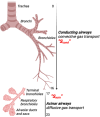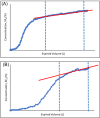Looking beyond LCI: Multiple breath washout phase III slope derived indices and their application in chronic respiratory disease in children
- PMID: 39031489
- PMCID: PMC11601015
- DOI: 10.1002/ppul.27177
Looking beyond LCI: Multiple breath washout phase III slope derived indices and their application in chronic respiratory disease in children
Abstract
The multiple breath washout (MBW) test is widely reported in the context of Lung Clearance Index (LCI). LCI reflects global ventilation inhomogeneity but does not provide information regarding the localization of disease along the respiratory tree. The MBW-derived normalized phase III slope (SnIII) indices (Scond and Sacin), instead, can distinguish between convective-dependent and diffusion-convection-dependent ventilation inhomogeneity considered to occur within the conductive and acinar airways, respectively. In cystic fibrosis, Scond tends to become abnormal even earlier than LCI and spirometry. The value of Scond and Sacin in clinical practice has been recently explored in other respiratory conditions, including asthma, primary ciliary dyskinesia, bronchopulmonary dysplasia, bronchiolitis obliterans, and sickle cell disease. In this narrative review we offer an overview on the theoretical background, potentialities, and limitations of SnIII analysis in children, including challenges and feasibility aspects. Moreover, we summarize current evidence on the use of SnIII-derived indices across different groups of pediatric chronic respiratory disease and we highlight the gaps in knowledge that need to be addressed in future studies.
Keywords: children; cystic fibrosis; multiple breath washout; phase III slope analysis; ventilation inhomogeneity.
© 2024 The Author(s). Pediatric Pulmonology published by Wiley Periodicals LLC.
Conflict of interest statement
Mollie Riley reports speaker honoraria from Vertex Pharmaceuticals outside of this submitted work. Gwyneth Davies reports speaker honoraria from Chiesi Ltd and Vertex Pharmaceuticals, and advisory board and clinical trial leadership roles with Vertex Pharmaceuticals, outside of this submitted work. The remaining authors declare no conflict of interest.
Figures



Similar articles
-
Feasibility and Utility of Multiple Breath Washout Measured Scond and Sacin in Preschool Children With Cystic Fibrosis.Pediatr Pulmonol. 2025 Jun;60(6):e71180. doi: 10.1002/ppul.71180. Pediatr Pulmonol. 2025. PMID: 40552665
-
Limitations of regional ventilation inhomogeneity indices in children with cystic fibrosis.Pediatr Pulmonol. 2020 Sep;55(9):2315-2322. doi: 10.1002/ppul.24863. Epub 2020 Jun 1. Pediatr Pulmonol. 2020. PMID: 32441886
-
Assessing the calculation of conductive and acinar ventilatory heterogeneity indices Scond and Sacin from multiple-breath washout data.J Appl Physiol (1985). 2023 Apr 1;134(4):879-886. doi: 10.1152/japplphysiol.00423.2022. Epub 2023 Feb 24. J Appl Physiol (1985). 2023. PMID: 36825644
-
Inert gas washout: background and application in various lung diseases.Swiss Med Wkly. 2017 Aug 16;147:w14483. doi: 10.4414/smw.2017.14483. eCollection 2017. Swiss Med Wkly. 2017. PMID: 28871575 Review.
-
[Lung clearance index in cystic fibrosis].Rev Mal Respir. 2019 Mar;36(3):377-395. doi: 10.1016/j.rmr.2018.03.007. Epub 2019 Jan 25. Rev Mal Respir. 2019. PMID: 30686561 Review. French.
Cited by
-
Inhomogeneity of lung ventilation in children with obesity and its potential role in worsening asthma.Physiol Rep. 2025 Apr;13(8):e70257. doi: 10.14814/phy2.70257. Physiol Rep. 2025. PMID: 40243130 Free PMC article.
References
-
- Prisk GK, Lauzon AM, Verbanck S, et al. Anomalous behavior of helium and sulfur hexafluoride during single‐breath tests in sustained microgravity. J Appl Physiol. 1996;80(4):1126‐1132. - PubMed
-
- Aurora P, Bush A, Gustafsson P, et al. Multiple‐breath washout as a marker of lung disease in preschool children with cystic fibrosis. Am J Respir Crit Care Med. 2005;171(3):249‐256. - PubMed
-
- Crawford AB, Makowska M, Paiva M, Engel LA. Convection‐ and diffusion‐dependent ventilation maldistribution in normal subjects. J Appl Physiol. 1985;59(3):838‐846. - PubMed
-
- Verbanck S, Schuermans D, Van Muylem A, Paiva M, Noppen M, Vincken W. Ventilation distribution during histamine provocation. J Appl Physiol. 1997;83(6):1907‐1916. - PubMed
Publication types
MeSH terms
LinkOut - more resources
Full Text Sources

